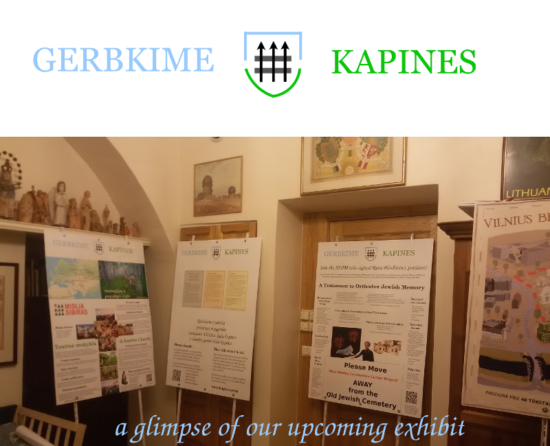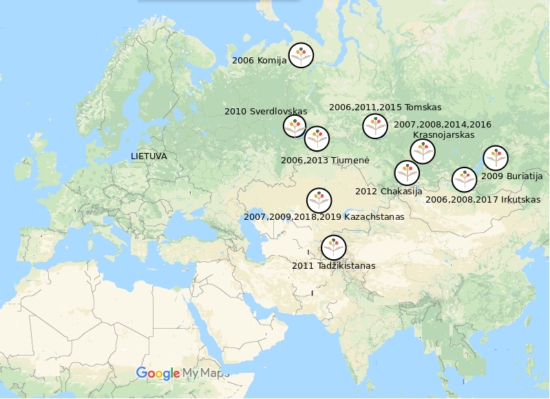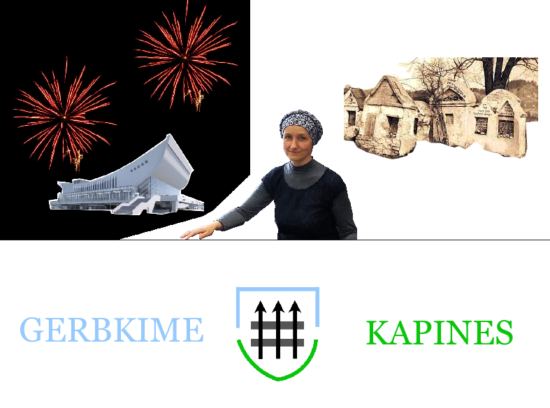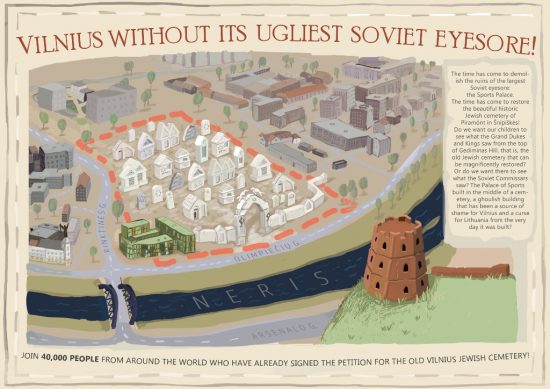OPINION | HUMAN RIGHTS | CHRISTIAN-JEWISH ISSUES | CEMETERIES & MASS GRAVES | OLD VILNA JEWISH CEMETERY AT PIRAMÓNT | OPPOSITION TO CONVENTION CENTER PROJECT | INTERNATIONAL PETITION
◊
by Andrius Kulikauskas
◊
◊
Respect Cemeteries (Gerbkime kapines) is a group of individuals in Lithuania who are working together to keep our country from operating a convention center at the Vilnius Sports Palace on top of the oldest Jewish cemetery in Vilnius. We are focusing on this crisis as the most vital issue to address in fostering Lithuanian and Litvak friendship.
Our approach is to embrace and explore the value of respecting all cemeteries with special attention to Lithuanian points of view. Arkadij Kurliandchik, an elected member of the board of the Vilnius Jewish Community, advises that we won’t be heard in Lithuania if we portray the fate of the Vilnius Jewish Cemetery as a Jewish special interest issue. Instead, if we care about our general humanity, and if we appreciate Lithuanian issues, then we hope to discover the righteous Lithuanians who will argue with us against cynical Lithuanian politicians and developers, and against their ally, the official Lithuanian Jewish Community.
Our first public event is an exhibit of posters on Sunday, June 14, from 11 AM to 1 PM, along the sidewalk between Rinktinės St. and the Soviet-built Vilnius Sports Palace. We relate two movements to respect cemeteries, one focused on Siberia, and the other on Vilnius. Let us first consider the circumstances by which up to 600 Lithuanian cemeteries arose in a vast territory stretching from Vorkuta, near the Arctic Sea, to Tajikistan, near Afghanistan, and to Irkustk, near Mongolia.
In Lithuania, June 14th is the Day of Mourning and Hope. We remember the Soviet atrocities, including the trauma of June 14-19, 1941, when the Soviets deported about 17,600 people from Lithuania, including former President Aleksandras Stulginskis, former ministers, civic leaders, successful entrepreneurs, upstanding citizens, prominent intellectuals, 5,120 children, 1,200 teachers and 79 priests. These victims included at least 2,000 Jews and 1,600 Poles.
The Soviets decimated Lithuania’s moral leadership, created class divisions, provoked ethnic hatred, robbed the people and tore the social fabric. They established abysmal preconditions for the Holocaust in Lithuania, where Nazi Germans and Lithuanian collaborators murdered about 200,000 local Jews.
In September, 1939, as part of their Molotov-Ribbentrop Pact with Nazi Germany, the Soviets occupied the Vilnius region. They immediately deported about 25,000 Polish and Jewish residents. In 1940-1941 and 1944-1953, the Soviets forcibly removed from Lithuania about 130,000 deportees and about 150,000 political prisoners, which is to say, more than 10% of the population, which was about 2,500,000 at the time. In 1944, about 80,000 Lithuanians fled in the face of the second Soviet occupation, ending up as refugees in Germany and then the West. In 1945-1947, as part of their occupation of Eastern Europe, the Soviets impelled an additional 330,000 Poles in the Vilnius region to “choose” to give up their roots and leave for Poland.
One of our posters tells the story of Mission Siberia (Misija Sibiras), a youth initiative which since 2006 has organized annual expeditions to care for Lithuanian cemeteries in Siberia. I spoke with Gintautas Alekna, who led their expeditions from 2006 to 2014.
In 1989, as part of the Lithuanian Reawakening, the local Communist Youth party organized the first and largest ever expedition of about 80 enthusiasts to care for the graves of Lithuanians in Siberia. Subsequently, Gintautas Alekna and several other participants formed the Fate Association (Bendrija “Lemtis”), which has documented about 85% of these cemeteries.
In 2005, such disparate efforts took on a massive scale when the Lithuanian Youth Organization Council (LiJOT) started Mission Siberia to show the patriotism of Lithuanian youth even as we entered the European Union. This initiative has received widespread admiration and also government funding. Every year, more than a thousand youth apply, taking the opportunity to speak with their older relatives and learn their family histories. Seventy-five are selected for a trial journey, and then 15 are chosen for the 2 week expedition. The team documents and takes care of cemeteries. They also make and erect large wooden crosses in the cross-crafting tradition recognized by UNESCO as part of world heritage. Upon their return, they spend a year meeting with young and old, showing photo exhibits and documentary films.
We might learn from Mission Siberia how to interest our youth, how to imagine our Vilnius Jewish Cemetery as a destination which might inspire respect from near and far. When and where our youth leads, then and there our government ultimately, inevitably follow.
Our second poster shows that likewise a mass movement cares for the fate of the Vilnius Jewish Cemetery. Over 50,000 people around the world have signed Ruta Bloshtein’s petition, “Please Move New Vilnius Convention Center Project AWAY from the Old Jewish Cemetery” (DH’s report).
Ruta has been touched by the comments left by those who signed, and presented us with six pages of them. We made a poster which displays ten comments that urge different reasons why we should respect the cemetery and build the convention center elsewhere. Here are Ruta’s two favorite comments:
“This is a very important testament to history and continuation of the tradition passed down from biblical times in the middle east. Huge works of commentary were created in Vilna as well. The preservation of the cemetery makes the huge contributions the people of this city made more relevant for future generations.”
—Bert Berookhim (Allston, MA)
◊
“Every Orthodox Jew is concerned about the Jews buried in the Vilna cemetery. Their names are very familiar to us. We study their books and tell stories about them. Please don’t desecrate their memory by building any building at all in that cemetery. Thank you very much.”
— Yaacov Lieberman (Far Rockaway, NY)
Our final poster is the classic by Julius Norwilla which urges us to dismantle our monstrous Soviet heritage and restore this cemetery as our blessed memory of the Grand Duchy of Lithuania. Certainly, this romantic spirit may inspire our youth to dream of what might be.
Once a month, our group “Respect Cemeteries” will be organizing an exhibit to keep presenting new perspectives on how and why we should respect our cemeteries, notably the oldest Vilnius Jewish cemetery. We will present our exhibits in the Lithuanian press. We believe that our commitment will make it impossible to erase this cemetery, and indeed, our faithful activity will brand the site as the cemetery that it is and ever will be. We expect to dissuade any potential operators of a convention center from attempting to profit here.
Currently, there are ten of us. Arkadij Kurliandchik is our event organizer. I am the curator of our exhibits and the editor of our website www.kapines.com (“Kapinės” means “cemetery”). Others are: Edmundas Kulikauskas, Valdas Valiunas, Chaimas Bargmanas, Polina Pailis, Evaldas Balčiūnas, Ruta Bloshtein, Julius Norwilla, Regina Kopilevich. We meet weekly by Zoom.
Our priority now is to expand our circle in Lithuania with historians, journalists, clergy, artists, translators, and other volunteers. Future exhibits might consist of editorial cartoons, architectural proposals for a convention center elsewhere in Vilnius, a presentation of the history of the Vilnius Jewish Cemetery, or biographies of notable figures buried there. We also are coordinating our efforts with international friends, notably Dov and Chaya Fried of SaveVilna.org
Yet I expect to keep reaching out more broadly. I see parallels with Lithuania’s Calvinists (evangelikai reformatai), who are raising funds to build a monument to their heroes at Reformation square, where the Soviets destroyed their cemetery. I am also impressed by the work of Visuomeninė Rasų kapinių draugija, a group of Lithuania’s Polish intellectuals, who since 1990 have cared for Lithuania’s national cemetery, Rasų kapinės, which the Soviets cut in half with a road. Hundreds of thousands of Polish pilgrims flock to ancestral Lithuania and visit the cemetery, which includes the grave of Polish President Józef Piłsudski’s mother and his own heart beside her, as well as the grave of Jonas Basanavičius, the patriarch of Lithuania. Whereas the Russian government has since 2018 denied visas to Lithuanian expeditions which care for cemeteries there, and so the expeditions have been traveling to Kazakshtan instead.
Andrius Kulikauskas, ms@ms.lt, +370 607 27 665



